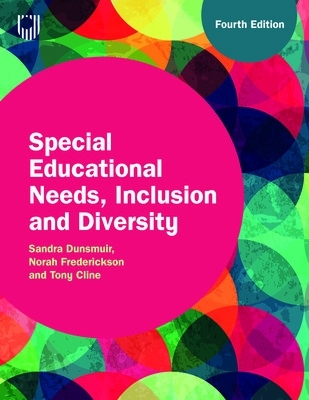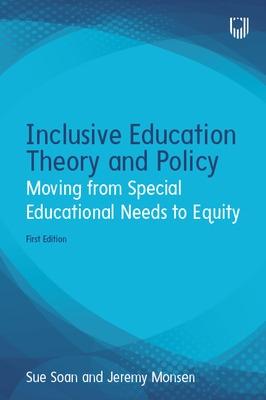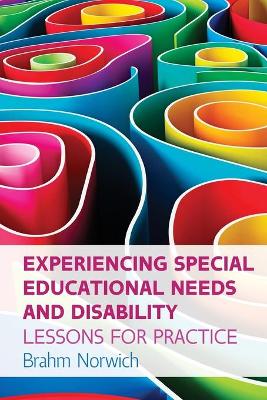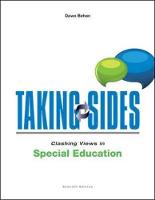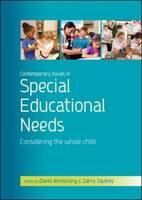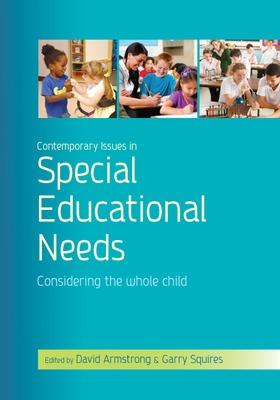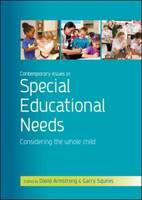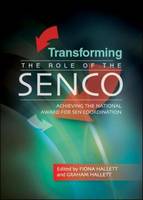CREATE COLLECTION ONLY Annual Editions: Educating Children with Exceptionalities, 22/e
 portes grátis
portes grátis
CREATE COLLECTION ONLY Annual Editions: Educating Children with Exceptionalities, 22/e
Freiberg, Karen
McGraw-Hill Education - Europe
12/2013
192
Mole
Inglês
9780078112300
15 a 20 dias
Why Can't We Say "Handicapped"? Texas Child Care, 2008
First person language helps students in inclusive settings feel more abled rather than disabled. "A child with an orthopedic impairment" is preferred over "a wheelchair child." This article gives other suggestions for empowering children who are visually impaired, hearing impaired, speech impaired, and intellectually disabled.
The Legal List: Top 10 Issues, Del Stover and Glenn Cook, American School Board Journal, 2009
A growing number of lawsuits against schools have resulted from the Americans with Disabilities Act (ADA), the Individuals with Disabilities Education Act (IDEA), and No Child Left Behind (NCLB). Court cases cost money and leave adults afraid of conflict resolution. This article discusses major legal issues involved in special education today.
The Issues of IDEA, Joetta Sack-Min, American School Board Journal, 2007
This article is an excellent overview of how IDEA has impacted special education. It gives the history of legal requirements, family involvement, IEPs, and accountability. It explains the current dilemmas: more use of accommodations and technology, increased enrollments and decreased funding.
Use Authentic Assessment Techniques to Fulfill the Promise of No Child Left Behind, Carol A. Layton and Robin H. Lock, Intervention in School and Clinic, 2007
This article gives 20 ways to make assessments and accommodations for students with disabilities more appropriate and precise. IEP teams struggle to fulfill the legal mandates of NCLB and IDEA for specific results to guide instructional practices. These suggestions meet the needs for authenticity and accountability.
Does This Child Have a Friend? Mary M. Harrison, Teaching Tolerance, 2007
Mary Harrison, a freelance writer, describes the advent of social inclusion programs in middle schools across the United States. With parents advocating for IDEA's principles, instructional methods which emphasize social skills (e.g., Gym Friends; Yes I Can) are experiencing unexpected successes, even for students with autistic spectrum disorders.
UNIT: Learning Disabilities
Beyond Special Education: A New Vision of Academic Support, Julie Joyal Mowschenson and Robert J. Weinraub, Phi Delta Kappan, 2009
This article describes a new approach to special education and inclusive education for high school students with learning disabilities: a tutorial program. Researchers have validated that this instructional method reduces paperwork, saves money, improves students' and teachers' morale, and is enthusiastically supported by parents.
Learning-Disabled Enrollment Dips after Long Climb, Christina A. Samuels, Education Week, 2010
This article suggests that IDEA's mandate for early intervention may be reducing the numbers of students with LD assessments. The instructional method "response to intervention" has helped many elementary school children learn to read. Another reason for declining numbers may be the identification of more students as OHI or ASD for accountability purposes.
Dyslexia and the Brain: What Does Current Research Tell Us? Roxanne F. Hudson, Leslie High, and Stephanie Al Otaiba, The Reading Teacher, 2007
Imaging brain studies have revealed differences in hemisphere size, grey and white matter, and metabolism in persons with dyslexia. There is no cure. However, early intervention and family involvement can prevent fear of failure and low self-esteem. Instructional methods that work are described, as well as ways to assess progress and demonstrate accountability.
Build Organizational Skills in Students with Learning Disabilities, Rita F. Finstein, Fei Yao Yang, and Rachele Jones, Intervention in School and Clinic, 2007
Students with learning disabilities often earn disappointing grades due to poor organizational skills. This article suggests 20 instructional methods to support their learning in diverse ways. Among the hints: parental, mentor and peer participation, organization as an IEP goal, multiple types of reminders, and instruction in prioritizing and time management.
UNIT: Mental Retardation/Intellectual Disabilities (IDs)
Prenatal Screening for Down Syndrome, Vijaya Krishna Varanasi, Gynecology & Obstetrics, 2011
Prenatal screening for Down Syndrome, a chromosomal-based cause of intellectual disability, has involved invasive diagnostic procedures such as chorionic villus sampling (CVS) or amniocentesis. A new DNA-based technology, involving just a simple blood test, will be available soon. This safer method will enhance both parents' and children's futures.
Intellectual Disabilities, National Dissemination Center for Children with Disabilities, Disability Fact Sheet, 2009
Intellectual disabilities are defined and illustrated with a vignette. The causes, assessment, prevalence and signs of IDs are outlined. This selection gives tips to parents and teachers for helping children with IDs. Early intervention, special education, IEP goals such as communication and social skills, and transition plans are featured.
Music Therapy: Teachers Strike an Emotional Chord with Disabled Students, Lisa Black, Chicago Tribune, 2009
The author discusses the benefits of music therapy with students with both intellectual disabilities and ADHD. Brain development is stimulated by music. This instructional method can also strengthen breathing in students with health impairments (wind instruments).
Self-Determination for Students with Intellectual Disabilities, Susan Unok Marks, Phi Delta Kappan, 2008
The author presents three key ideas about self-determination for students with intellectual disabilities (IDs). She argues that inclusive education is more democratic, and that self-determination for people with IDs is an inalienable right.
UNIT: Emotional and Behavioral Disorders (EBDs)
Young Women in Jail Describe Their Educational Lives, Signe Nelson and Lynn Olcott, American Jails, 2009
This article gives voice to a group of young at-risk women with emotional-behavior disorders who have been incarcerated. Most dropped out of high school or were expelled. When asked about education, most reported that they were "hands-on" learners. They wanted kinesthetic instructional methods (do) over reading or listening. This has important SPED implications.
Improving the Way We Think about Students with Emotional and/or Behavioral Disorders, Kelley S. Regan, Teaching Exceptional Children, 2009
The author recommends four "R" considerations that can improve the instructional methods for students with EBDs. They are reflexion, relationships, roles, and resources. The IEPs should include positive behavioral interventions, ways to earn students' trust, and the kinds of resources which will help each student achieve success.
Teaching Children with Challenging Behavior, Caltha Crowe, Educational Leadership, 2010
Caltha Crowe recommends getting to know elementary school students with EBDs as the most important first step in designing instructional methods. It is valuable to understand their developmental stage, their learning style, their social skills, what triggers their challenging behaviors, and what's likeable about each one. Families can provide much of this information.
Rethinking How Schools Address Student Misbehavior and Disengagement, Howard S. Adelman and Linda Taylor, Addressing Barriers to Learning, 2008
The authors, co-directors of the UCLA School Mental Health Project, based in the Center for Mental Health in Schools, believe that many discipline problems could be eliminated by whole school initiatives that create and sustain an environment that addresses positive social and emotional development as well as academics.
UNIT: Speech and Language Impairments (S/L)
New Approaches to the Study of Childhood Language Disorders, Susan Nittrouer and Bruce Pennington, Current Directions in Psychological Science, 2010
The authors compare perception of phonetic structures in speech to catching a fish with bare hands for children with language deficits. This article describes speech perception, and explains why it contributes to both communication disorders and learning disorders. Research on how global and detailed structures in speech are integrated might lead to better instructional methods for language disorders.
Broadening Our View of Linguistic Diversity, Debra O'Neal and Marjorie Ringler, Phi Delta Kappan, 2010
The target language for all American students is academic English. All people have some linguistic diversity, whether a cultural dialect or a different mother tongue. Differences are not language disorders, although they are often assessed as such. Learning academic English is required to be successful in school. We all need to code-switch from our social milieu dialect to academic English, or be bi-dialectual.
Assessment and Intervention for Bilingual Children with Phonological Disorders, Brian A. Goldstein and Leah Fabiano, The ASHA Leader, 2007
Over 5 million students with limited English proficiency attend U.S. elementary schools. Many have communication disorders, especially in articulation/phonology. Assessment is complicated. The authors suggest five essential elements. Developin
g an IEP and providing appropriate inclusive education requires speech language pathologist collaboration and family/cultural considerations.
Caring Closes the Language-Learning Gap, Mary Borba, Phi Delta Kappan, 2009
Learning the syntax of one's first language has a positive effect on speech/language acquisition in English. Mary Borda suggests ways to involve immigrant families in school (e.g., field trips, cafeteria), while encouraging them to embrace both languages and cultures with their children. Technology (e.g., ESL computer software) can be made available.
UNIT: Hearing and Visual Impairments
The Debate over Deaf Education, Burton Bollag, Chronicle of Higher Education, 2006
This commentary about the education of children with hearing impairments reveals that the average 18-year-old with deafness reads below the 4th grade level. Debates about learning oral-English, versus American Sign Language (ASL), are raging as cochlear implants make oral-English practicable. Cognition is stunted without some language. Educators and IEPs should consider each individual's needs.
Braille Literacy Lags, Even as Technology Makes It More Urgent, Amy Brittain, The Christian Science Monitor, 2007
Technology for the education of children with blindness (e.g., audio and computer aids) has reduced the number of Braille readers to about 12%. This has serious consequences for future employment. Literacy can and should be taught to all students with blindness.
Towards Integrated Practices in Early Detection of and Intervention for Deaf and Hard of Hearing Children, Claudine Storbeck and Jennifer Calvert-Evers, American Annals of the Deaf, 2008
Undetected hearing loss has a profound effect on children's communication and cognition. This article describes a program of screening of high-risk infants and children, and early intervention for those with loss. Parent-advisors and deaf mentors provided home-based support. In addition, parent meetings occurred frequently. Key factors in the success of the multidisciplinary approach are identified.
UNIT: Orthopedic Impairments (OIs) and Other Health Impairments (OHIs)
Writing Explicit, Unambiguous Accommodations: A Team Effort, MaryAnn Byrnes, Intervention in School and Clinic, 2008
Accommodations level the playing field by removing barriers for students with disabilities (e.g., orthopedic and health impairments). IDEA mandates accommodations for assessments (e.g., extended time) and classroom instruction (e.g., scribing, preferential seating). They are legal entities. The author gives guidelines for entering them into IEPs in explicit, unambiguous ways.
ADHD and the SUD in Adolescents, Timothy E. Wilens, Paradigm, 2006
In this article, the author explains the overlap between teens with attention deficit hyperactive disorder (ADHD) and substance use disorder (SUD).
Demography: Youth Depression and Suicide, Rick Docksai, The Futurist, 2009
Doctors must weigh risks vs. benefits when prescribing antidepressant drugs for youth. All brands are now mandated by the Food and Drug Administration to carry a warning that use may damage self-esteem and increase suicidality in young patients.
Nursing Injuries, Perry A. Zirkel, Phi Delta Kappan, 2011
"Who Administers Medication?" In California, the courts ruled that only nurses could administer insulin injections to students whose IEPs or 504 plans required them (unless the student could self-administer). Other states allow trained school employees to give injections, and perform other medical procedures. Such legal dilemmas are bound to increase.
UNIT: Autism and Autism Spectrum Disorders (ASDs)
Autism, the Law, and You, Edwin C. Darden, American School Board Journal, 2007
This article explains the legal implications of parents pushing for early intervention, collaboration, accommodations, and specific instructional methods for their child with autism in public school. IDEA mandates an individualized education program (IEP) that is free and appropriate and meets all SPED needs, including communication. These are high priced.
New Views into the Science of Educating Children with Autism, Martha S. Burns, Phi Delta Kappan, 2013
Autistic spectrum disorders (ASDs) are so unique that each child requires different accommodations. Communication, repetitive behaviors, and social skills may all reflect brain development. Under connections of long neural trait fibers may cause these problems. Exercises (including computer technology) can stimulate development of these fibers and enhance learning.
Pharmacotherapy and Children with Autism Spectrum Disorder: A Tutorial for Speech-Language Pathologists, Trisha L. Self, LaDonna S. Hale, and Daiquirie Crumrine, Language, Speech and Hearing Services in Schools, 2010
The team approach to treating autism spectrum disorders (ASDs) includes speech-language pathologists, behaviorists, family, school, and health care staff. Medications can be useful for hyperactivity, self-injury, repetitive acts, seizures, and/or mood swings. They should be used in conjunction with behavioral intervention. This paper reports possible side effects of several different drugs.
UNIT: Gifted and Talented (G/T)
Is Genius Genetic or Is It Nurtured? Joe Smydo, Pittsburgh Post-Gazette, 2010
The author reviews the lives of some creative geniuses, and states that some amazing abilities are genetically based. However, a rigorous practice regimen in an area of ability can change brain development. A third factor contributing to gifted and talented people is strong curiosity plus a strong work ethic which has been described as a "rage to learn."
From Perfection to Personal Bests: Seven Ways to Nurture Your Gifted Child, Signe Whitson, Psychology Today Passive Aggressive Diaries Blog, 2011
Many gifted and talented children are perfectionists. They have a "fixed mindset," all-or-nothing thinking. They avoid trying new activities for fear they will not instantly excel. The author gives seven suggestions for helping children develop a "growth mindset." They need to learn that practice makes perfect. Families and teachers can focus on incremental progress and persistence rather than goal achievement.
Creating a Personal Technology Improvement Plan for Teachers of the Gifted, Kevin Besnoy, Gifted Child Today, 2007
Technology is beneficial for educating students with special gifts and talents. This article presents a five-step process of assessing, implementing, and evaluating computer hardware and software for gifted education. This plan increases accountability for instructional methods used.
Why Can't We Say "Handicapped"? Texas Child Care, 2008
First person language helps students in inclusive settings feel more abled rather than disabled. "A child with an orthopedic impairment" is preferred over "a wheelchair child." This article gives other suggestions for empowering children who are visually impaired, hearing impaired, speech impaired, and intellectually disabled.
The Legal List: Top 10 Issues, Del Stover and Glenn Cook, American School Board Journal, 2009
A growing number of lawsuits against schools have resulted from the Americans with Disabilities Act (ADA), the Individuals with Disabilities Education Act (IDEA), and No Child Left Behind (NCLB). Court cases cost money and leave adults afraid of conflict resolution. This article discusses major legal issues involved in special education today.
The Issues of IDEA, Joetta Sack-Min, American School Board Journal, 2007
This article is an excellent overview of how IDEA has impacted special education. It gives the history of legal requirements, family involvement, IEPs, and accountability. It explains the current dilemmas: more use of accommodations and technology, increased enrollments and decreased funding.
Use Authentic Assessment Techniques to Fulfill the Promise of No Child Left Behind, Carol A. Layton and Robin H. Lock, Intervention in School and Clinic, 2007
This article gives 20 ways to make assessments and accommodations for students with disabilities more appropriate and precise. IEP teams struggle to fulfill the legal mandates of NCLB and IDEA for specific results to guide instructional practices. These suggestions meet the needs for authenticity and accountability.
Does This Child Have a Friend? Mary M. Harrison, Teaching Tolerance, 2007
Mary Harrison, a freelance writer, describes the advent of social inclusion programs in middle schools across the United States. With parents advocating for IDEA's principles, instructional methods which emphasize social skills (e.g., Gym Friends; Yes I Can) are experiencing unexpected successes, even for students with autistic spectrum disorders.
UNIT: Learning Disabilities
Beyond Special Education: A New Vision of Academic Support, Julie Joyal Mowschenson and Robert J. Weinraub, Phi Delta Kappan, 2009
This article describes a new approach to special education and inclusive education for high school students with learning disabilities: a tutorial program. Researchers have validated that this instructional method reduces paperwork, saves money, improves students' and teachers' morale, and is enthusiastically supported by parents.
Learning-Disabled Enrollment Dips after Long Climb, Christina A. Samuels, Education Week, 2010
This article suggests that IDEA's mandate for early intervention may be reducing the numbers of students with LD assessments. The instructional method "response to intervention" has helped many elementary school children learn to read. Another reason for declining numbers may be the identification of more students as OHI or ASD for accountability purposes.
Dyslexia and the Brain: What Does Current Research Tell Us? Roxanne F. Hudson, Leslie High, and Stephanie Al Otaiba, The Reading Teacher, 2007
Imaging brain studies have revealed differences in hemisphere size, grey and white matter, and metabolism in persons with dyslexia. There is no cure. However, early intervention and family involvement can prevent fear of failure and low self-esteem. Instructional methods that work are described, as well as ways to assess progress and demonstrate accountability.
Build Organizational Skills in Students with Learning Disabilities, Rita F. Finstein, Fei Yao Yang, and Rachele Jones, Intervention in School and Clinic, 2007
Students with learning disabilities often earn disappointing grades due to poor organizational skills. This article suggests 20 instructional methods to support their learning in diverse ways. Among the hints: parental, mentor and peer participation, organization as an IEP goal, multiple types of reminders, and instruction in prioritizing and time management.
UNIT: Mental Retardation/Intellectual Disabilities (IDs)
Prenatal Screening for Down Syndrome, Vijaya Krishna Varanasi, Gynecology & Obstetrics, 2011
Prenatal screening for Down Syndrome, a chromosomal-based cause of intellectual disability, has involved invasive diagnostic procedures such as chorionic villus sampling (CVS) or amniocentesis. A new DNA-based technology, involving just a simple blood test, will be available soon. This safer method will enhance both parents' and children's futures.
Intellectual Disabilities, National Dissemination Center for Children with Disabilities, Disability Fact Sheet, 2009
Intellectual disabilities are defined and illustrated with a vignette. The causes, assessment, prevalence and signs of IDs are outlined. This selection gives tips to parents and teachers for helping children with IDs. Early intervention, special education, IEP goals such as communication and social skills, and transition plans are featured.
Music Therapy: Teachers Strike an Emotional Chord with Disabled Students, Lisa Black, Chicago Tribune, 2009
The author discusses the benefits of music therapy with students with both intellectual disabilities and ADHD. Brain development is stimulated by music. This instructional method can also strengthen breathing in students with health impairments (wind instruments).
Self-Determination for Students with Intellectual Disabilities, Susan Unok Marks, Phi Delta Kappan, 2008
The author presents three key ideas about self-determination for students with intellectual disabilities (IDs). She argues that inclusive education is more democratic, and that self-determination for people with IDs is an inalienable right.
UNIT: Emotional and Behavioral Disorders (EBDs)
Young Women in Jail Describe Their Educational Lives, Signe Nelson and Lynn Olcott, American Jails, 2009
This article gives voice to a group of young at-risk women with emotional-behavior disorders who have been incarcerated. Most dropped out of high school or were expelled. When asked about education, most reported that they were "hands-on" learners. They wanted kinesthetic instructional methods (do) over reading or listening. This has important SPED implications.
Improving the Way We Think about Students with Emotional and/or Behavioral Disorders, Kelley S. Regan, Teaching Exceptional Children, 2009
The author recommends four "R" considerations that can improve the instructional methods for students with EBDs. They are reflexion, relationships, roles, and resources. The IEPs should include positive behavioral interventions, ways to earn students' trust, and the kinds of resources which will help each student achieve success.
Teaching Children with Challenging Behavior, Caltha Crowe, Educational Leadership, 2010
Caltha Crowe recommends getting to know elementary school students with EBDs as the most important first step in designing instructional methods. It is valuable to understand their developmental stage, their learning style, their social skills, what triggers their challenging behaviors, and what's likeable about each one. Families can provide much of this information.
Rethinking How Schools Address Student Misbehavior and Disengagement, Howard S. Adelman and Linda Taylor, Addressing Barriers to Learning, 2008
The authors, co-directors of the UCLA School Mental Health Project, based in the Center for Mental Health in Schools, believe that many discipline problems could be eliminated by whole school initiatives that create and sustain an environment that addresses positive social and emotional development as well as academics.
UNIT: Speech and Language Impairments (S/L)
New Approaches to the Study of Childhood Language Disorders, Susan Nittrouer and Bruce Pennington, Current Directions in Psychological Science, 2010
The authors compare perception of phonetic structures in speech to catching a fish with bare hands for children with language deficits. This article describes speech perception, and explains why it contributes to both communication disorders and learning disorders. Research on how global and detailed structures in speech are integrated might lead to better instructional methods for language disorders.
Broadening Our View of Linguistic Diversity, Debra O'Neal and Marjorie Ringler, Phi Delta Kappan, 2010
The target language for all American students is academic English. All people have some linguistic diversity, whether a cultural dialect or a different mother tongue. Differences are not language disorders, although they are often assessed as such. Learning academic English is required to be successful in school. We all need to code-switch from our social milieu dialect to academic English, or be bi-dialectual.
Assessment and Intervention for Bilingual Children with Phonological Disorders, Brian A. Goldstein and Leah Fabiano, The ASHA Leader, 2007
Over 5 million students with limited English proficiency attend U.S. elementary schools. Many have communication disorders, especially in articulation/phonology. Assessment is complicated. The authors suggest five essential elements. Developin
g an IEP and providing appropriate inclusive education requires speech language pathologist collaboration and family/cultural considerations.
Caring Closes the Language-Learning Gap, Mary Borba, Phi Delta Kappan, 2009
Learning the syntax of one's first language has a positive effect on speech/language acquisition in English. Mary Borda suggests ways to involve immigrant families in school (e.g., field trips, cafeteria), while encouraging them to embrace both languages and cultures with their children. Technology (e.g., ESL computer software) can be made available.
UNIT: Hearing and Visual Impairments
The Debate over Deaf Education, Burton Bollag, Chronicle of Higher Education, 2006
This commentary about the education of children with hearing impairments reveals that the average 18-year-old with deafness reads below the 4th grade level. Debates about learning oral-English, versus American Sign Language (ASL), are raging as cochlear implants make oral-English practicable. Cognition is stunted without some language. Educators and IEPs should consider each individual's needs.
Braille Literacy Lags, Even as Technology Makes It More Urgent, Amy Brittain, The Christian Science Monitor, 2007
Technology for the education of children with blindness (e.g., audio and computer aids) has reduced the number of Braille readers to about 12%. This has serious consequences for future employment. Literacy can and should be taught to all students with blindness.
Towards Integrated Practices in Early Detection of and Intervention for Deaf and Hard of Hearing Children, Claudine Storbeck and Jennifer Calvert-Evers, American Annals of the Deaf, 2008
Undetected hearing loss has a profound effect on children's communication and cognition. This article describes a program of screening of high-risk infants and children, and early intervention for those with loss. Parent-advisors and deaf mentors provided home-based support. In addition, parent meetings occurred frequently. Key factors in the success of the multidisciplinary approach are identified.
UNIT: Orthopedic Impairments (OIs) and Other Health Impairments (OHIs)
Writing Explicit, Unambiguous Accommodations: A Team Effort, MaryAnn Byrnes, Intervention in School and Clinic, 2008
Accommodations level the playing field by removing barriers for students with disabilities (e.g., orthopedic and health impairments). IDEA mandates accommodations for assessments (e.g., extended time) and classroom instruction (e.g., scribing, preferential seating). They are legal entities. The author gives guidelines for entering them into IEPs in explicit, unambiguous ways.
ADHD and the SUD in Adolescents, Timothy E. Wilens, Paradigm, 2006
In this article, the author explains the overlap between teens with attention deficit hyperactive disorder (ADHD) and substance use disorder (SUD).
Demography: Youth Depression and Suicide, Rick Docksai, The Futurist, 2009
Doctors must weigh risks vs. benefits when prescribing antidepressant drugs for youth. All brands are now mandated by the Food and Drug Administration to carry a warning that use may damage self-esteem and increase suicidality in young patients.
Nursing Injuries, Perry A. Zirkel, Phi Delta Kappan, 2011
"Who Administers Medication?" In California, the courts ruled that only nurses could administer insulin injections to students whose IEPs or 504 plans required them (unless the student could self-administer). Other states allow trained school employees to give injections, and perform other medical procedures. Such legal dilemmas are bound to increase.
UNIT: Autism and Autism Spectrum Disorders (ASDs)
Autism, the Law, and You, Edwin C. Darden, American School Board Journal, 2007
This article explains the legal implications of parents pushing for early intervention, collaboration, accommodations, and specific instructional methods for their child with autism in public school. IDEA mandates an individualized education program (IEP) that is free and appropriate and meets all SPED needs, including communication. These are high priced.
New Views into the Science of Educating Children with Autism, Martha S. Burns, Phi Delta Kappan, 2013
Autistic spectrum disorders (ASDs) are so unique that each child requires different accommodations. Communication, repetitive behaviors, and social skills may all reflect brain development. Under connections of long neural trait fibers may cause these problems. Exercises (including computer technology) can stimulate development of these fibers and enhance learning.
Pharmacotherapy and Children with Autism Spectrum Disorder: A Tutorial for Speech-Language Pathologists, Trisha L. Self, LaDonna S. Hale, and Daiquirie Crumrine, Language, Speech and Hearing Services in Schools, 2010
The team approach to treating autism spectrum disorders (ASDs) includes speech-language pathologists, behaviorists, family, school, and health care staff. Medications can be useful for hyperactivity, self-injury, repetitive acts, seizures, and/or mood swings. They should be used in conjunction with behavioral intervention. This paper reports possible side effects of several different drugs.
UNIT: Gifted and Talented (G/T)
Is Genius Genetic or Is It Nurtured? Joe Smydo, Pittsburgh Post-Gazette, 2010
The author reviews the lives of some creative geniuses, and states that some amazing abilities are genetically based. However, a rigorous practice regimen in an area of ability can change brain development. A third factor contributing to gifted and talented people is strong curiosity plus a strong work ethic which has been described as a "rage to learn."
From Perfection to Personal Bests: Seven Ways to Nurture Your Gifted Child, Signe Whitson, Psychology Today Passive Aggressive Diaries Blog, 2011
Many gifted and talented children are perfectionists. They have a "fixed mindset," all-or-nothing thinking. They avoid trying new activities for fear they will not instantly excel. The author gives seven suggestions for helping children develop a "growth mindset." They need to learn that practice makes perfect. Families and teachers can focus on incremental progress and persistence rather than goal achievement.
Creating a Personal Technology Improvement Plan for Teachers of the Gifted, Kevin Besnoy, Gifted Child Today, 2007
Technology is beneficial for educating students with special gifts and talents. This article presents a five-step process of assessing, implementing, and evaluating computer hardware and software for gifted education. This plan increases accountability for instructional methods used.

